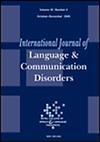Towards an Agreed Labelling System and Protocol for the Diagnosis of Speech Sound Disorder Subtypes in the United Kingdom
Abstract
Background
There is no single classification system or diagnostic protocol for speech sound disorder (SSD). This makes it difficult to collect large-scale outcome data and determine which interventions work best for which subtypes of SSD. The United Kingdom is unique in that its publicly funded healthcare system allows the collection of such outcome data across large numbers of children; however, a necessary first step towards this is to agree on a consistent diagnostic protocol and classification system for SSD that is feasible for use in the UK healthcare system.
Aims
This study aimed to achieve an initial clinician-led UK consensus on a diagnostic protocol and classification system for SSD of unknown origin.
Methods and Procedures
A mixed methods participatory design was used. Five UK health services provided SSD paperwork such as local guidelines and protocols for content analysis. Two participatory workshops were used to agree on: (1) a classification system, (2) subtype labels and definitions, and (3) a feasible diagnostic protocol for SSD. The finalised consensus was presented to a national meeting of 283 SLTs to determine the feasibility of the protocol for clinicians across the whole of the United Kingdom.
Outcomes and Results
Workshop participants agreed that the Differential Diagnostic Classification System was preferred for the United Kingdom. A minimum diagnostic protocol, with additional assessment for complex SSD, was agreed. Over 90% of the national SLT meeting agreed that they could implement the definitions and protocol.
Conclusions and Implications
A preliminary diagnostic protocol, classification system, and subtype names and definitions were agreed upon and are broadly in line with those proposed by Dodd (2014). Future work will trial the consensus protocol and classification system in the United Kingdom to investigate treatment outcomes and refine the protocol.
WHAT THIS PAPER ADDS
- There are three main classification systems for speech sound disorder (SSD) that are popular globally: the Speech Disorder Classification System (SDCS) (Shriberg et al. 2019); the Differential Diagnostic Classification System (Dodd 2014); and the Psycholinguistic Framework (Stackhouse and Wells 1993). It is not clear which of these, if any, is most used in the United Kingdom. Moreover, previous research suggests that clinicians employ a wide range of different terms for subtypes of SSD and different diagnostic methods to arrive at these subtypes. This lack of consistency, even within the United Kingdom, is confusing for parents, carers, and practitioners and makes it difficult to compare outcomes.
- We showed that most clinicians in the United Kingdom use the Differential Diagnostic Classification System (Dodd 2014). We therefore suggest that this is now used consistently in the United Kingdom, with some modifications. A feasible diagnostic protocol which includes using the assessment designed specifically for this classification system, the Diagnostic Evaluation of Articulation and Phonology (Dodd et al. 2002), was agreed for clinical use.
- Clinicians in the United Kingdom can use the subtype labels and diagnostic protocol described here to diagnose subtypes of SSD in a consistent manner. Children with more complex SSD or concomitant disorders will require additional assessments.


 求助内容:
求助内容: 应助结果提醒方式:
应助结果提醒方式:


